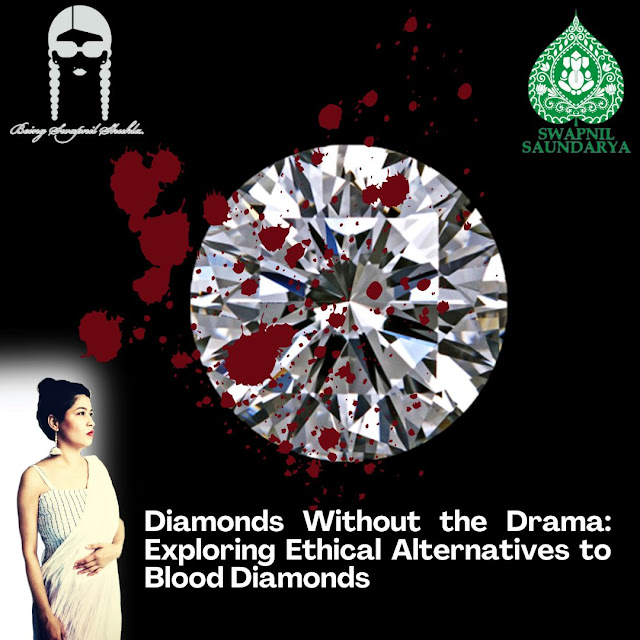Diamonds Without the Drama: Exploring Ethical Alternatives to Blood Diamonds | By Swapnil Shukla
Can you have a diamond without the bloodshed? As awareness of the grim realities of blood diamonds grows, consumers are increasingly seeking ethical alternatives. Let’s explore the sparkling world beyond conflict stones and discover diamonds that shine without a dark past.
The Diamond Dilemma: Why Blood Diamonds Are Problematic
Blood diamonds, also known as conflict diamonds, are mined in war zones and sold to finance armed conflict against governments. While they’ve been depicted in films and documentaries, the real story is often far more brutal, involving human rights violations, child labor, and environmental destruction. So, how do we indulge our love for diamonds without endorsing this painful legacy?
1. Lab-Grown Diamonds: The Shining Solution
Lab-grown diamonds are created in controlled environments using advanced technology that replicates the natural diamond-growing process. They’re chemically, physically, and optically identical to mined diamonds—but without the ethical baggage.
The Perks:
Eco-Friendly: Lab-grown diamonds have a significantly lower environmental impact compared to their mined counterparts, which can lead to deforestation and habitat destruction.
Affordable: Generally, lab-grown diamonds cost 20-40% less than mined diamonds, allowing you to buy bigger and better at a lower price.
Transparency: Since lab-grown diamonds come from controlled environments, they come with a guarantee of ethical sourcing.
2. Moissanite: The Sparkling Impostor
If you’re looking for an alternative that sparkles just as bright, consider moissanite. This gem, originally discovered in a meteorite, is now lab-created and is known for its brilliance and fire.
The Perks:
Similar Look: Moissanite can closely resemble diamonds and often has more sparkle due to its higher refractive index.
Cost-Effective: Generally cheaper than diamonds, moissanite allows for stunning, affordable jewelry options.
Ethically Produced: Being lab-created, moissanite is free from the ethical concerns surrounding mined stones.
3. Vintage and Antique Diamonds: The Reclaimed Beauty
Choosing vintage or antique diamonds not only adds character to your jewelry but also helps reduce the demand for newly mined stones. These diamonds come with a story and a rich history, allowing you to wear something unique.
The Perks:
Sustainability: By opting for pre-owned diamonds, you contribute to sustainability efforts and help keep beautiful pieces out of landfills.
Unique Finds: Vintage jewelry often has intricate designs that aren’t commonly found in modern pieces, allowing for a distinctive style.
Value Appreciation: Antique pieces can appreciate in value over time, making them a smart investment.
4. Ethical Mined Diamonds: The Right Choice?
While not all mined diamonds are considered blood diamonds, ethical mined diamonds come from sources that adhere to strict labor and environmental standards. Organizations like the Kimberley Process aim to regulate the diamond trade, ensuring that stones are sourced responsibly.
The Perks:
Certified Sources: Ethical mined diamonds are often certified by third-party organizations, providing buyers with some assurance of ethical practices.
Support Communities: When sourced ethically, these diamonds can help improve the living conditions of local communities by providing fair wages and safe working conditions.
5. Alternative Gemstones: The Colorful Options
Why limit yourself to diamonds when there’s a world of stunning gemstones out there? From sapphires and emeralds to garnets and topaz, these colorful alternatives can make beautiful and meaningful pieces of jewelry.
The Perks:
Diverse Styles: A wider variety of gemstones allows for unique designs that can express personal style.
Cultural Significance: Many gemstones hold cultural or historical significance, making them even more special as heirloom pieces.
Ethical Sourcing: Many alternative gemstones can be ethically sourced, allowing for guilt-free purchasing.
Making the Switch: Your Role in the Ethical Diamond Movement
Switching to ethical alternatives isn’t just a personal choice; it’s a statement against the blood diamond trade. As consumers demand more transparency and ethical practices, jewelers are starting to respond, leading to a gradual change in the industry.
By choosing ethical options, you send a message that you value compassion over conflict, beauty over bloodshed.
The Bottom Line: Diamonds Can Be Different
In a world that’s becoming increasingly conscious of ethical consumption, there’s no need to settle for blood diamonds. Whether you opt for lab-grown diamonds, moissanite, vintage pieces, ethical mined stones, or colorful alternatives, there’s a sparkling option out there for everyone.
As we explore these alternatives, let’s redefine what diamonds represent. Instead of symbols of conflict, let’s make them symbols of love, compassion, and ethical choices. After all, a true diamond shines brightest when it’s free from the shadows of its past.
Be the reason someone believes in magic.
Swapnil Shukla, a pioneering jewelry designer and IGI-Certified Polished Diamond Grader, has redefined the jewelry and fashion industry by inventing the genre of Jewelry Journalism in Hindi. As India's first Jewelry Journalist, her innovative work bridges the gap between high-end jewelry trends and sustainability, making them accessible to Hindi-speaking audiences. A passionate advocate for eco-friendly practices, Swapnil has brought cultural heritage, history, and symbolism into her narratives, contributing to the preservation of indigenous jewelry traditions. Her trailblazing efforts are transforming jewelry journalism into a literary art, setting new benchmarks for responsible design and storytelling.
No part of this publication may be reproduced , stored in a retrieval system or transmitted , in any form or by any means, electronic, mechanical, photocopying, recording or otherwise, without the prior permission of the copyright owner.
Copyright infringement is never intended, if we published some of your work, and you feel we didn't credited properly, or you want us to remove it, please let us know and we'll do it immediately.







Comments
Post a Comment